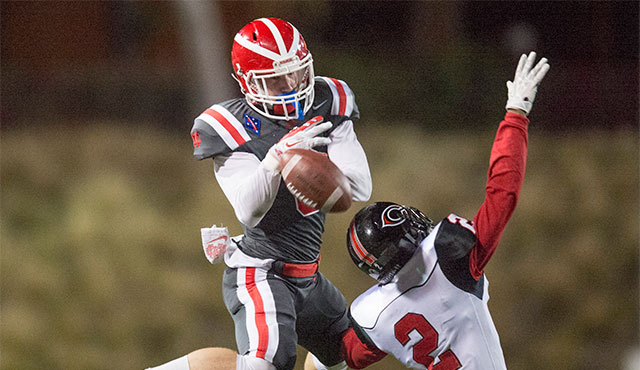When Santa Margarita Catholic High golfer Catharine Roddy isn’t tearing up the links, she can be seen playing first chair cello with the school orchestra or acing advance placement exams. When Servite linebacker Nico Ament isn’t dishing out hits on the gridiron, he may be dishing out meals to the homeless. Rosary soccer star Noelle Nisco is gaining notoriety as the school’s first All-American in sports medicine.
These are just some of the Trinity League students finding academic and civic success can be as rewarding as athletic accomplishment.
While the image of the dumb jock may still hold a place in some minds, in many schools that’s no longer the case. Increasingly, research shows that in high school academic and athletic success are linked.
In the Trinity League, athletics are part of well-rounded curricula. Athletes may be considered big men and women on campus because of their sporting feats, but nowadays they are also among the standout academics.
Take Daniel “DJ” Bailey. The star defensive end for JSerra spurned football scholarships from prominent schools to take his 4-plus GPA and football skills to Harvard, which has strong sports but does not offer athletic scholarships. He had to make it on brain power.
“He’s walking away from D-I scholarships,” says Jim Hartigan, Bailey’s coach and athletic director at Serra.
Last year, Hayley Wan of Santa Margarita, a two-time CIF player of the year in water polo, went the route of Bailey, trading athletic scholarships for Ivy at Princeton. The Junior Olympian also plays a mean piano. This year, the Eagles have Stanford-bound state champion pole vaulter Kaitlyn Merritt, with a 4.7 GPA. And junior football quarterback K.J. Costello, a top national recruit, has a 4.1 GPA.
Mater Dei football this year was led by Ben Humphreys, a coveted recruit who carried a 4.19 GPA and is headed to Duke University.
At Rosary High School Nisco is a four-year varsity starter in soccer and a club player who is enrolled in four AP classes, with well above a 4.0 GPA. She also is near-fluent in sign language for the deaf.
More and more, the dumb jock label simply doesn’t fit.
It’s not easy, but sports and outside interests can coexist.
“Trying to find every edge possible can be a full-time job for parents and students,” Hartigan says. It’s up to parents and coaches to help students find the right balance, he adds.
Rich Schaaf, the athletic director at Santa Margarita, where athletes have an average 3.57 GPA, has a simple solution.
“Don’t lose your sense of humor,” says the educator with 28 years at the school. “The kids I see work hard and have high goals. But the one thing they have in common is a great sense of humor. It keeps them from going over the edge. After a game at the end of the day, they know what’s important.”
Academics take a front seat at Rosary, where between 87 percent and 91 percent of athletes maintain a 3.0 or better GPA, says Rob Ickes, the school’s athletic director.
“That’s something we’re very proud of,” he says, noting the varsity tennis, golf and volleyball teams had GPAs of 3.9 or better and in three of his four years at the school athletes have been valedictorians or salutatorians. How do they do it? To Ickes, combining sports and academics is about time management and scheduling.
Some stellar athletes pass on college sports.
“(Sports) may not be in their wheelhouse because their aspirations are so much higher academically,” Ickes says.
Schaaf says, “The kids I respect most are the ones that do well academically.”
Proponents of athletics say sports carry benefits beyond the scoreboard, from overall fitness to discipline and teamwork. Hartigan adds grittiness, perseverance, the ability to handle crises and quick decision-making to the list.
A “Journal of Sport Administration & Supervision” study found Kansas scholar-athletes had higher grades, graduation rates and test scores and lower drop-out rates. The author of a “Journal of Research” study found “high schools that devote more energy to athletic success also tend to produce more academic success.“
Bruce Rollinson, football coach at Mater Dei, says the real accomplishment is helping the student who isn’t academically gifted.
“Anyone can teach a Ben Humphreys,” he says. “The challenge is to teach the C student to strive for a B. I ask, ‘What are you doing for them?’ That’s the challenge.”
Hartigan says elite athletes who are offered sports scholarships may not have to carry the 4-plus GPAs others need to get into a Stanford or Notre Dame, but still must meet tough baseline requirements of those schools.
In other words, the term student-athlete no longer has to be an oxymoron.

